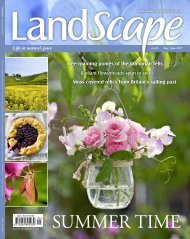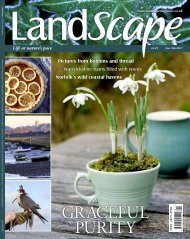LandScape sampler Mar/Apr 17
LandScape magazine celebrates the joy of the garden, simple seasonal recipes, traditional British crafts and the wonder of nature and the countryside. Published eight times a year, the magazine is a haven from the pressures of modern living; a chance to slow down and a reminder of the good things in life.
LandScape magazine celebrates the joy of the garden, simple seasonal recipes, traditional British crafts and the wonder of nature and the countryside. Published eight times a year, the magazine is a haven from the pressures of modern living; a chance to slow down and a reminder of the good things in life.
You also want an ePaper? Increase the reach of your titles
YUMPU automatically turns print PDFs into web optimized ePapers that Google loves.
<strong>LandScape</strong> - Life at nature’s pace Hepaticas | Riverside garden | Daffodils in containers | Welsh classic recipes | A life afloat | Oil drum art work | Weaving willow | Barn owls | The Hope Valley <strong>Mar</strong> / <strong>Apr</strong> 20<strong>17</strong><br />
Life at nature’s pace<br />
1<br />
Issue 37 | <strong>Mar</strong> / <strong>Apr</strong> 20<strong>17</strong> | £4.50<br />
www.landscapemagazine.co.uk<br />
Glowing memories of a day by the sea<br />
Capturing nature’s artwork in metal<br />
£4.50 <strong>Mar</strong> / <strong>Apr</strong> 20<strong>17</strong><br />
The mysterious twisted oaks of Dartmoor<br />
NEW LIFE<br />
ABOUNDS
Contents<br />
<strong>Mar</strong> / <strong>Apr</strong> 20<strong>17</strong><br />
94<br />
104 38<br />
In the garden<br />
In the kitchen<br />
Craft<br />
10 The dainty charm of hepaticas<br />
18 Colour awakens in a Kent garden<br />
32 The garden in... <strong>Mar</strong>ch and <strong>Apr</strong>il<br />
38 Containers of golden daffodils<br />
46 Bread takes centre stage<br />
52 Battenburg is all wrapped up<br />
54 Classics from the Welsh table<br />
58 Regional & Seasonal:<br />
Ye Old Sparrowhawk<br />
26 Delicate hedgerow blossom<br />
42 Creating a haven for bumblebees<br />
72 Glowing shell candles<br />
80 Wellington cuffs to knit<br />
92 Building a forest den<br />
100 Wooden refuge for barn owls<br />
4
72<br />
26<br />
88<br />
46<br />
Country matters<br />
History and heritage<br />
Regulars<br />
74 Nature’s artwork caught in metal<br />
82 Twisted wood full of mystery<br />
88 The beauty of woven stems<br />
94 Stealth of a winged hunter<br />
62 Life on a restored narrowboat<br />
104 Valley shaped by man’s influence<br />
114 Vital bible of herbal medicine<br />
6 Readers’ letters<br />
8 Our <strong>LandScape</strong><br />
36 In the garden<br />
44 In the kitchen<br />
60 Subscription offer<br />
70 In the home<br />
120 UK events<br />
5
The varied hues of dainty<br />
hepaticas emerge like a<br />
scattering of jewels as<br />
milder weather arrives.<br />
10
With their tiny, star-like flowers<br />
in exquisite colours, hepaticas<br />
bring their own delicate charm<br />
to the early spring garden<br />
HEAVENLY<br />
BEAUTIES
TEATIME SQUARES<br />
Wrapped in marzipan, the two-coloured Battenberg cake<br />
has been a British favourite for 200 years<br />
52
Serves 10<br />
<strong>17</strong>5g unsalted butter, plus extra for greasing<br />
<strong>17</strong>5g caster sugar<br />
3 eggs<br />
½ tsp baking powder<br />
<strong>17</strong>5g self-raising flour<br />
pink food colouring<br />
25g ground almonds<br />
4 tbsp apricot jam<br />
icing sugar, to dust<br />
500g ready-to-roll golden marzipan<br />
Preheat the oven to 180°C/gas mark 4 and grease<br />
a 15 x 20cm ovenproof dish liberally. Cut out two<br />
squares of baking paper to fit the two shorter ends<br />
of the dish and place them in position. Measure out<br />
a rectangle of baking paper to fit the remainder of<br />
the dish, then allow another third again on the<br />
width. Fold up the middle, greasing the inner fold so<br />
it stays in place, to create a divider for the different<br />
coloured batters. There is now one side for the<br />
yellow sponge and another for the pink (1).<br />
Place a large mixing bowl on scales and set them<br />
to zero. Cream the butter into the sugar in the bowl<br />
for 2-3 mins, until fluffy. Beat in the eggs, one at a<br />
time, until smooth, then stir in the baking powder.<br />
Weigh the mixture again and place exactly half into<br />
a separate mixing bowl. Sift 100g of the flour into<br />
one of the mixtures and fold in until completely<br />
incorporated. A drop at a time, add two or three<br />
drops of food colouring, until the mixture is the<br />
desired level of pinkness. Food colouring brands<br />
vary, so also check the instructions on the label.<br />
With the remaining batter, sift in the rest of the<br />
flour and add the almonds. Fold the flour and<br />
almonds into the batter until combined. Transfer the<br />
mixture into one side of the tin, smoothing with a<br />
spatula. Pour the pink mixture into the other side.<br />
Make sure the middle piece of baking paper is held<br />
in place, and both sides are equal and flat on top<br />
(1). Bake for 25-30 mins, until an inserted skewer<br />
comes out clean. Allow to cool for 5 mins, then<br />
remove from the tin and paper to cool completely.<br />
Next, create four long sticks of sponge, perfectly<br />
equal in size. Even up the sides of the two sponge<br />
rectangles with a sharp knife on a chopping board.<br />
Measure the sides of the sponge pieces with a ruler<br />
to make sure they are the same size. Slice more<br />
sponge away if necessary. Measure the middle point<br />
of a short end of the piece of sponge and mark with<br />
a small cut. Do the same with the other short end of<br />
the piece and then the middle. Cut a long line from<br />
the bottom to the top, so there are two equal<br />
lengths. Do the same with the other piece of sponge<br />
(2). The tops of the strips may need to be levelled<br />
to make them square.<br />
In a small bowl, combine the jam with 2 tbsp of<br />
boiling water. Brush one yellow strip of sponge with<br />
the mixture on its right side. Stick a pink strip next<br />
to it, and brush the tops of the strips with jam.<br />
Brush the other pink strip’s right side with the jam.<br />
Place it on top of the yellow strip already brushed<br />
with jam. Then place the remaining yellow strip next<br />
to it, holding them all together so they stick (3).<br />
On a clean surface dusted with icing sugar, roll<br />
out the marzipan to approximately 40cm squared.<br />
At the end of one side of the marzipan, cut a<br />
straight line with a sharp knife. Coat one side of the<br />
cake with the jam mixture, then place that side<br />
lengthways on top of it and in the middle of the<br />
side. Roll the cake in the marzipan, smoothing the<br />
sides down (4). When the beginning of the marzipan<br />
sheet is reached, take a sharp knife and cut the<br />
marzipan to line up with the adjoining side.<br />
Place the cake join-side down, then cut away the<br />
excess marzipan from the ends and smooth (5).<br />
Chill for 30 mins to set, then slice to serve.<br />
• Recipe: Liz O'Keefe • Photography: Food & Foto; Stockfood<br />
1. 2. 3.<br />
4. 5.<br />
53
The ruins of Peveril Castle sit on an outcrop<br />
of limestone overlooking Castleton and the<br />
Hope Valley in Derbyshire. Behind is the<br />
sharp, shale face of Mam Tor.<br />
SCULPTED BY HISTORY<br />
104
From Iron Age forts on hilltops to caverns deep below ground, man’s influence<br />
has helped forge the wild landscape of Derbyshire’s beautiful Hope Valley<br />
105
NATURE’S ARTISTRY<br />
SEARED IN METAL<br />
The strength of a discarded oil drum lid frames a delicate work<br />
of art created by Jeni Cairns at her Fenland home<br />
74
Jeni’s oil drum<br />
designs encapsulate<br />
her love of gardens,<br />
artistic skills<br />
and passion for<br />
recycling.
WILD HIDEAWAY<br />
Constructed from sticks and dry leaves, this simple<br />
den provides a base for outdoor adventure<br />
SPENDING TIME PLAYING outdoors sparks children’s<br />
imaginations. An extra element of adventure is created by<br />
building a den. It can form a base for an afternoon’s<br />
exploration as well as providing shelter from the elements.<br />
This simple, one-person hideout is constructed under adult<br />
supervision to ensure it will not collapse. Adults can also help<br />
in clearing away heavy logs and stones, as well as keeping an eye<br />
on the proceedings.<br />
HOW TO MAKE A<br />
WOODLAND DEN<br />
A level, safe spot beside a forked tree is chosen for the<br />
site of the den. Then three straight sticks are collected,<br />
each approximately 3ft (1m) taller than the den<br />
occupant. The end of one stick is placed into the tree<br />
fork. The other end rests on the ground, so the stick is<br />
at an angle. The remaining two sticks are placed on the<br />
ground to either side, creating the outline of a triangle<br />
shape. By lying down within the outline, the builder can<br />
check the frame is the right size.<br />
Shorter sticks are collected and arranged all the way<br />
along each side of the shelter. A gap is left near the tree<br />
on one side to form an entrance. The sticks are placed<br />
close together, with the top of each resting on the ridge<br />
pole. Layers of gathered crispy leaves are built up over<br />
the frame, starting at ground level, to form a deep<br />
thatch. More dry leaves are used to create a padded<br />
floor inside the den.<br />
Secure and thick leaf cover creates a cosy den that will keep the<br />
rain out. A porch-like entrance is made using forked sticks on<br />
each side with more supported between them to create a lintel.<br />
Adapted from<br />
THE DEN BOOK BY<br />
FIONA DANKS AND<br />
JO SCHOFIELD<br />
Published by Frances<br />
Lincoln, £12.99.<br />
www.franceslincoln.com<br />
93
Bring every season to life in<br />
your home with <strong>LandScape</strong><br />
8<br />
issues<br />
a year<br />
GORGEOUS GARDENING<br />
We celebrate the beauty and diversity of the British garden<br />
and its plants. You’ll find inspiration and advice as we invite<br />
you into gardens where nature and nurture flourish.<br />
INSPIRATIONAL COOKERY<br />
Every issue has tempting recipes that make the most of the<br />
season’s produce. You’ll find new ways to enjoy traditional<br />
favourites for every meal.<br />
EXQUISITE CRAFT<br />
Enjoy discovering how to create beautiful decorations using<br />
seasonal flowers and foliage. Follow our step-by-step guides<br />
to creating simple crafts for home and garden.<br />
Enjoyed this free issue?<br />
Subscribe here now...<br />
CELEBRATING HERITAGE<br />
Read about the craftsmen and women who are keeping<br />
Britain’s traditional skills alive. Visit towns, villages and<br />
countryside that encapsulates the country’s proud history.<br />
CHANGING COUNTRYSIDE<br />
Learn about the animals and birds that inhabit our fields,<br />
rivers and seas. And we explain how there’s more to many of<br />
our farm animals than meets the eye.<br />
LIVE LIFE AT NATURE’S PACE WITH








